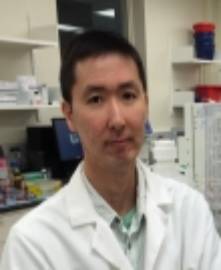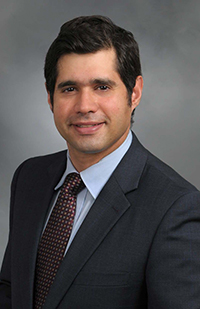Faculty
|
|
Jorge L. Benach, Ph.D.Distinguished University Professor |
| The major focus of our research is on the pathogenesis of spirochetal infections and their host responses, particularly in the developmental bactericidal antibodies that work independently of the complement system. These antibodies appear to be more common than previously thought, and may be a very important part of the host repertoire against bacteria. We are also interested in the interaction of spirochetal outer surface components with host proteases to enhance invasiveness, and to understand how this borrowed proteolytic activity enhances penetration of these organisms into the central nervous system. | |
|
|
Martha B. Furie, Ph.D.Professor of Pathology |
| The Furie laboratory has long been interested in understanding a key event in inflammation, namely how leukocytes migrate out of blood vessels to reach tissues infected with bacteria. Study of this event has been accomplished through an in vitro model that faithfully mimics the blood vessel wall and, more recently, using in vivo models of infection. A particular focus has been on understanding the inflammatory responses elicited by Borrelia burgdorferi, the agent of Lyme disease, and Francisella tularensis, the cause of tularemia and a potential bioweapon. Dr. Furie also directs Stony Brook University's Graduate Program in Genetics and is the Senior Associate Editor of The American Journal of Pathology. | |
|
|
A. Wali Karzai, Ph.D.Director, Center for Infectious Diseases |
| The overall goal of the Karzai lab is to gain new insights into how the fundamental processes of gene expression are integrated inside the cell. We seek to discover novel integrative links, and explore the biological significance and physiological contributions of these links to the fitness, survival, and virulence of pathogenic bacteria. Our current research is aimed at elucidating the mechanistic details of how the essential processes of protein translation, mRNA stability, and protein degradation are linked. We are particularly interested in investigating: 1) Molecular mechanisms that govern translation quality assurance; 2) Molecular basis for mRNA surveillance and selective nonstop mRNA decay; 3) Biochemical mechanisms of targeted proteolysis and the role of AAA+ proteases in bacterial pathogenesis; 5) Discovery of novel antibiotics and the exploration of new vaccine technologies. We use a combination of protein biochemistry, molecular genetics, functional genomics, bioinformatics, and structural approaches to determine the biological function and mechanism of action of RNA-protein complexes that participate in regulation of gene expression. Dr. Karzai is also the director of Stony Brook University's Graduate Program in Molecular Cellular Biology. | |
|
|
Hwan K. Kim, Ph.D.Assistant Professor of Microbiology and Immunology |
| The Kim laboratory members are deeply interested in understanding the mechanisms whereby
pathogenic microorganisms cause infectious diseases. Specifically, our research focuses
on identifying virulence genes whose products are essential for vector transmission,
pathogenesis, immune escape, and vaccine protection. We study multiple microorganisms
of public health significance, including Rickettsia (the causative agents of vector-borne
Spotted Fever and Typhus rickettsioses), Powassan virus (the causative agent of tick-borne
encephalitis), and Staphylococcus aureus (responsible for antibiotic-resistant recurrent
infections). We use combinations of techniques available for bioinformatics, genetics,
molecular biology, microbiology, and immunology to gain insights into the underlying
molecular and cellular mechanisms of host-pathogen-vector interactions. Dr. Kim's departmental web page |
|
|
|
Erich R. Mackow, Ph.D.Professor of Microbiology and Immunology |
|
Viruses alter receptor functions, cell signaling pathways and transcriptional responses to bypass antiviral immune and cellular programs and cause host, organ and tissue specific diseases. The Mackow lab investigates viral cell targeting and the regulation of vascular, pulmonary and CNS cell functions. We investigate mechanisms of Flavivirus (FV: Powassan virus, Zika virus, Dengue virus), SARS-CoV2 and Hantavirus (HV) pathogenesis. We define viral mechanisms of vascular permeability, age dependent neurovirulence and innate and adaptive immune regulation as potential virulence determinants. Our lethal age-dependent Powassan virus (POWV) murine model permits analysis of POWV directed CNS damage, age-dependent neurovirulence mechanisms and potential therapeutic approaches to preventing POWV neurodegeneration and long-term neurologic sequelae. We use POWV reverse genetics to compare WT and attenuated POWVs, and define determinants of POWV spread, neuroinvasion and CNS pathology. |
|
|
|
Nicole S. Sampson, Ph.D.Dean, College of Arts and Sciences |
| The Sampson laboratory has defined the mechanisms of protein catalysts that function
at the sterol:lipid interface. These studies have evolved to undertake the elucidation
of the mechanisms by which mycobacteria, e.g., M. tuberculosis, persist in their human
host. Her laboratory is pursuing a multi-pronged approach that includes elucidating
enzyme function, establishing metabolite structure and activity to identify the substrates
of key enzymes, identifying small molecules that interfere with the host immune response,
and developing metabolomic methods to screen these pathways for inhibitors. Of particular
interest are the M. Tuberculosis pathways for cholesterol metabolism. Dr. Sampson
is also the co-director of the Chemical Biology Training Program. Dr. Sampson's departmental web page |
|
|
|
Jessica C. Seeliger, Ph.D.Associate Professor of Pharmacological Sciences |
| Dr. Jessica Seeliger's laboratory investigates the mechanisms of lipid membrane biogenesis
in mycobacteria, especially the human pathogen Mycobacterium tuberculosis (Mtb). Mtb
generates many structurally complex and virulence-associated lipids that have received
little molecular-level scrutiny in the membrane context. The J. Seeliger group is
pursuing the question of how mycobacterial lipid membranes are synthesized and assembled
using a combination of protein biochemistry, microbiology and molecular genetics.
Additional research areas include the development and application of riboswitch-based
tools for inducible gene regulation and the attenuation of pathogenic strains by codon
pair bias deoptimization. Dr. J. Seeliger's departmental web page |
|
|
|
Brian S. Sheridan, Ph.D.Associate Professor of Microbiology and Immunology |
| The Sheridan laboratory is focused on understanding the mechanisms of pathogen-elicited
immune responses in mucosal tissues such as the intestine. The gastrointestinal tract
represents a major interface between the body and the environment and is constantly
exposed to numerous antigens from food intake, commensal bacteria and pathogens. Thus,
the intestinal immune system must concomitantly regulate inflammation to nonpathogenic
organisms while maintaining the capacity to rapidly generate an effective pathogen
specific immune response. The capacity to generate memory T cell populations and their
ability to migrate to and persist in the intestinal mucosa play a critical role in
protective immunity. This has underlined the importance of better understanding the
mechanisms regulating the development and homeostasis of memory T cells in the intestinal
mucosa. My lab utilizes recombinant Listeria that can invade the intestinal epithelium
of mice thereby recapitulating the physiologic route and entry point of Listeria infection
in humans. This system provides an excellent opportunity to understand the mechanisms
of intestinal T cell immunity and identify paradigms of mucosally acquired human pathogens
and inflammatory disorders of the gut. Dr. Sheridan's departmental web page |
|
|
|
David G. Thanassi, Ph.D.Professor and Chair of Microbiology and Immunology |
| Pathogenic bacteria must assemble and secrete virulence factors to interact with host
cells and cause disease. The Thanassi laboratory is interested in understanding virulence
protein secretion systems and the biogenesis of virulence-associated surface structures,
such as the hair-like adhesive fibers termed pili. We are also investigating the functions
of secreted virulence factors within the host, and the mechanisms by which these factors
contribute to bacterial survival and disease. We study a variety of bacterial pathogens,
including uropathogenic Escherichia coli, the predominant causative agent of urinary
tract infections, and Francisella tularensis, the causative agent of tularemia and
a potential bioterrorism agent. An overall goal of our studies is to develop targets
for the design of novel antimicrobial agents. Dr. Thanassi's departmental web page |
|
|
|
Peter J. Tonge, Ph.D.Professor of Chemistry |
| Research in the Tonge laboratory focuses on two major areas: (i) inhibitor discovery and the mechanism of drug action, and (ii) photoreceptor biophysics and biology. We use mechanistic enzymology to develop inhibitors of enzyme drug targets from pathogens such as Mycobacterium tuberculosis, Burkholderia pseudomallei, Pseudomonas aeruginosa, Klebsiella pneumoniae and methicillin-resistant Staphylococcus aureus (MRSA), and use techniques such as mass spectrometry and positron emission tomography to explore the role of drug-target binding kinetics in drug activity at the cellular and whole organism level. We also use biophysical methods such as ultrafast spectroscopy coupled with site-specific protein modification to understand the mechanism of photoreceptor activation as a prelude to the development of optogenetic devices. Dr. Tonge is the Director of Infectious Disease Research in the Institute for Chemical Biology & Drug Discovery, the co-Director of the Biomolecular Imaging Cluster, and the Director of the Translational Experimental Therapeutics Laboratory in the School of Medicine. Dr. Tonge is also an Associate Editor for ACS Infectious Diseases. | |
|
|
Adrianus W. M. van der Velden, Ph.D.Associate Professor of Microbiology and Immunology |
| Research conducted in the laboratory of Dr. van der Velden has been focused on host
interactions with bacterial pathogens, with an emphasis on the immunology of infection.
In particular, the laboratory of Dr. van der Velden has been studying the pathogenesis
of and host response to infection with Salmonella enterica serovar Typhimurium (S.
Typhimurium), a leading cause of morbidity and mortality in humans worldwide. The
laboratory of Dr. van der Velden uses a combination of molecular, cellular, biochemical
and immunological approaches to advance knowledge of mechanisms used by S. Typhimurium
to overcome the immune system. Dr. van der Velden's departmental web page |
|
|
|
Charles K. Vorkas, M.D.Assistant Professor of Medicine |
| Increasingly difficult to treat infections due to multi-drug resistant organisms and
lengthy antimicrobial regimens inspire our work to identify how innate lymphocytes
can be targeted in novel approaches to immune therapies and vaccine design. Our lab
employs human cohorts, murine models, and systems biology approaches in BSL2 and BSL3
settings to develop strategies to target innate lymphocytes against disease. |
|











